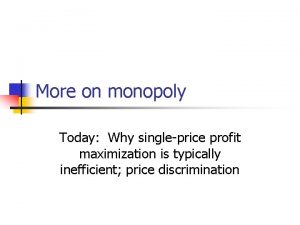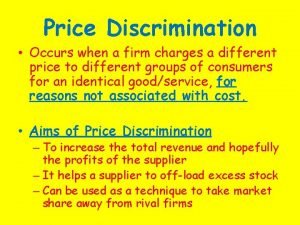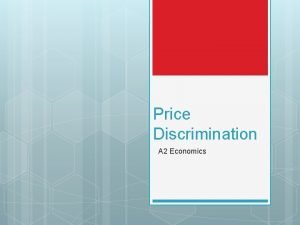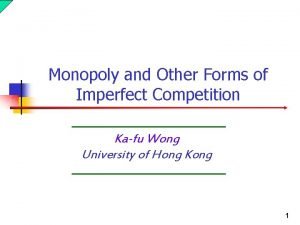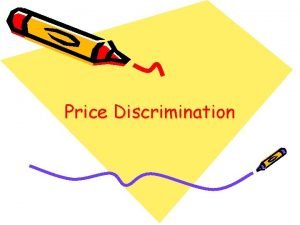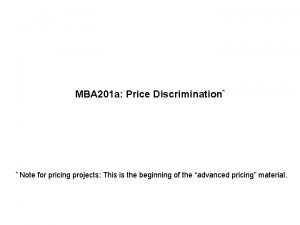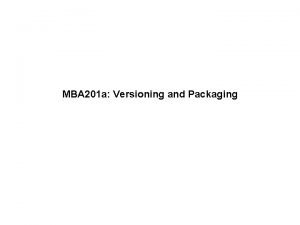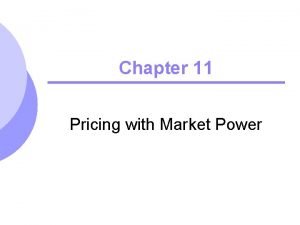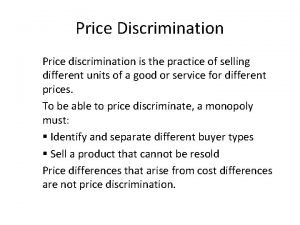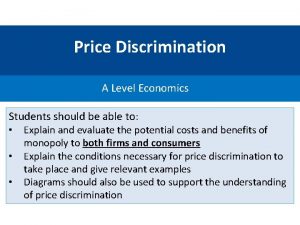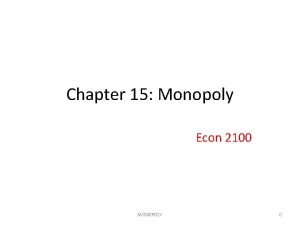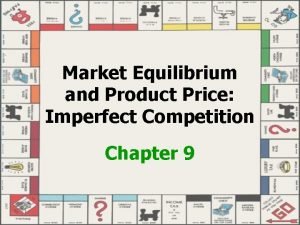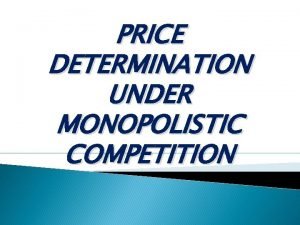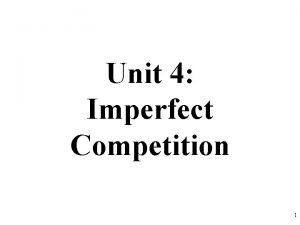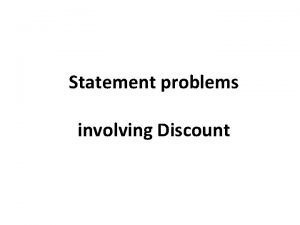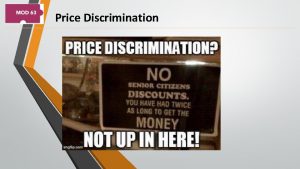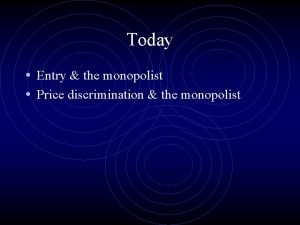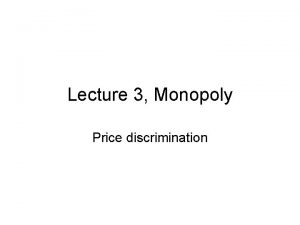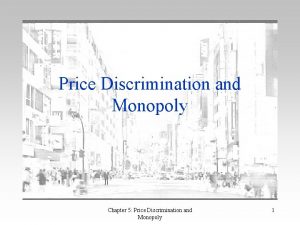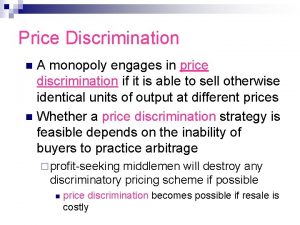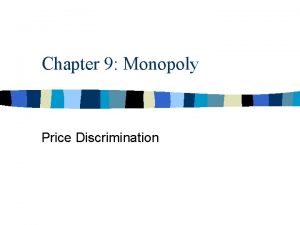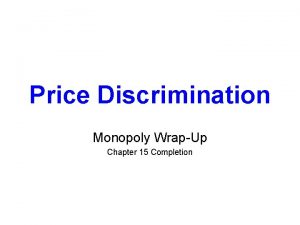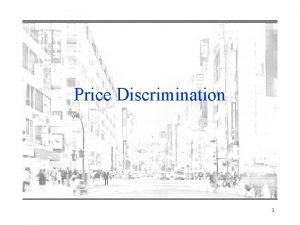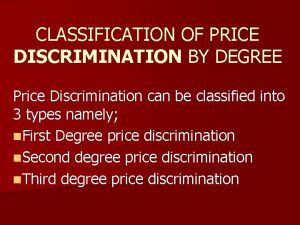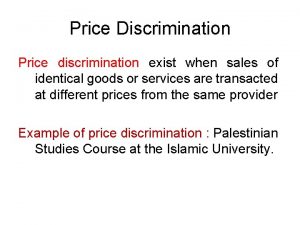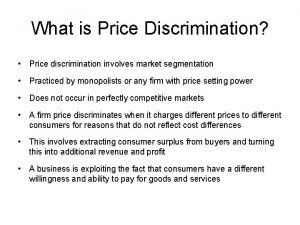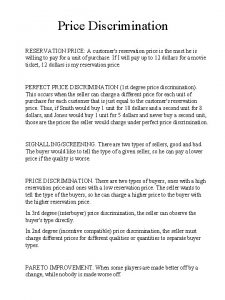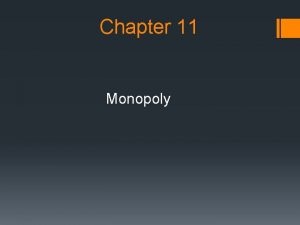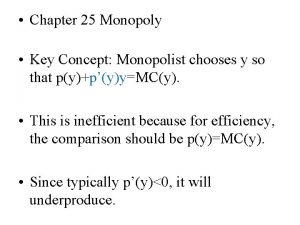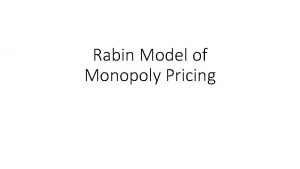Monopoly A SinglePrice Monopolist price discrimination A monopoly

















![The deadweight loss of monopoly Price MC [monopoly] = S [competition] pm p 0 The deadweight loss of monopoly Price MC [monopoly] = S [competition] pm p 0](https://slidetodoc.com/presentation_image_h2/6ef37bb2a441a1dbe7ed68eb1d47c780/image-18.jpg)












- Slides: 30

Monopoly

A Single-Price Monopolist: price discrimination A monopoly is an industry containing a single firm. - Price Maker. The firm has the ability to influence the price by varying the quantity sold which is also termed as market power. No substitutes, depending on the definition of market. No entry / completely blocked entry because of its technological advantage; its legal status etc. The monopoly firm maximises its profits by equating marginal cost to marginal revenue, which is less than price. Production under monopoly is less than it would be under perfect competition, where marginal cost is equated to price.

The Allocative Inefficiency of Monopoly By is allocatively inefficient. producing less than the perfectly competitive output it transfers some consumers’ surplus to its own profits and also causes deadweight loss of surplus that would have resulted from the output that is not produced.

A Multi-Price Monopolist If a monopolist can discriminate among either different units or different customers, it will always sell more and earn greater profits than if it must charge a single price. For price discrimination to be possible, the seller must be able to distinguish individual units bought by a single buyer or to separate buyers into classes among whom resale is impossible.

Long-run Monopoly Equilibrium A monopoly can earn positive profits in the long run if there are barriers to entry. These may be man-made, such as patents or exclusive franchises, or natural, such as economies of large-scale production.

Cartels as Monopolies The joint profits of all firms in a perfectly competitive industry can always be increased if they agree to restrict output. After agreement is in place, each firm can increase its profits by violating the agreement. If they all do this, profits are reduced to the perfectly competitive level.

Total, Average and Marginal Revenue Price p=AR Quantity q Total Revenue TR=p*q Marginal Revenue MR = TR/ q (£) (£) 9. 10 9 81. 90 8. 10 9. 00 10 90. 00 7. 90 8. 90 11 97. 90

Total, Average and Marginal Revenue · Marginal revenue is less than price because price must be lowered to sell an extra unit. · For example, consider the marginal revenue of the eleventh unit. · It is total revenue when eleven units are sold (£ 97. 90) minus total revenue when 10 units are sold (£ 90. 00) which is £ 7. 90. · This is less than the £ 8. 90 at which the eleventh unit is sold because the price on all previous 10 units must be cut by £ 0. 10 to raise sales by one unit.

Price The Effect on Revenue of an Increase in Quantity Sold p 0 p 1 Addition to revenues Reduction in revenue q 0 q 1 Quantity

The Effect on Revenue of an Increase in Quantity Sold · Because the demand curve has a negative slope, marginal revenue is less than price. · A reduction of price from p 0 to p 1 increases sales by one unit from q 0 to q 1 units. · The revenue from the extra unit sold is shown as the medium blue area. · To sell this unit, it is necessary to reduce the price on each of the q 0 units previously sold. · The loss in revenue is shown as the dark blue area. · Marginal revenue of the extra unit is equal to the difference between the two areas.

Revenue curves and demand elasticity Elasticity greater than one >1 £ per unit 10 Elasticity between zero and one 0 < <1 5 AR 0 50 Unity elasticity =1 100 MR -10 Quantity 250 TR £ 0 50 100 Quantity Over the range in which the demand curve is elastic, total revenue rises as more units are sold, marginal revenue must therefore be positive. Over the range in which the demand curve is inelastic, total revenue falls as more units are sold, marginal revenue must therefore, be negative.

Revenue curves and demand elasticity · Rising TR, positive MR, and elastic demand all go together. · In this example, for outputs from 0 to 50 units, marginal revenue is positive, elasticity is greater than unity, and total revenue is rising. · Falling TR negative MR and inelastic demand all go together. In this example, for outputs from 50 to 100 units, marginal revenue is negative, elasticity is less than unity, and total revenue is falling. (All elasticities refer to absolute not algebraic values. )

The Equilibrium of a Monopoly £ per unit MC ATC p 0 c 0 AVC MR 0 q 0 Profit-maximizing quantity D = AR Quantity

The Equilibrium of a Monopoly · The monopoly produces the output q 0 where marginal revenue equals marginal cost ( rule 2). · At this output, the price of p 0 (which is determined by the demand curve) exceeds the average variable cost (rule 1). · Total profit is the profit per unit of p 0 -c 0 multiplied by the output of q 0, which is the yellow area.

When the monoploy firmis in profit maximising equilibrium, equating margial rvenue with marginal cost, both are less than the price it charges for its output. Monopolist is choosing price and quantity simultaneously from the interaction of cost and demand conditions.

£ per unit No Supply Curve under Monopoly D” MC p 1 p 0 MR” 0 q 0 MR’ D’ The same output at different prices Quantity

No Supply Curve under Monopoly · The demand curves D’ and D’’ both have marginal revenue curves that intersect the marginal cost curve at output q 0. · But because the demand curves are different, q 0 is sold at: · p 0 when the demand curve is D’ and at p 1 when the demand curve is D’’. · Thus under monopoly there is no unique relation between price and the quantity sold.
![The deadweight loss of monopoly Price MC monopoly S competition pm p 0 The deadweight loss of monopoly Price MC [monopoly] = S [competition] pm p 0](https://slidetodoc.com/presentation_image_h2/6ef37bb2a441a1dbe7ed68eb1d47c780/image-18.jpg)
The deadweight loss of monopoly Price MC [monopoly] = S [competition] pm p 0 5 Em 6 Ec 1 7 Competitive price 2 D MR 0 qm q 0 Quantity

Allocative inefficiency of a monopoly Monopoly is alocatively inefficient because it does not maximize the sum of consumers’ and producer’ surpluses.

The deadweight loss of monopoly · At the perfectly competitive equilibrium Ec consumers’ surplus is the sum of the areas 1, 5, and 6. · When the industry is monopolized, price rises to pm, and consumers surplus falls to area 5. · Consumers lose area 1 because that output is not produced. · They lose area 6 because the price rise has transferred it to the monopolist. · Producers’ surplus in the competitive equilibrium is the sum of the areas 7 and 2.

The deadweight loss of monopoly · When the market is monopolized and price rises to pm, the surplus area 2 is lost because the output is not produced. · However the monopolist gains area 6 from consumers. Area 6 is known to be greater than 2 because pm maximizes the monopolist profits. · Thus although the monopolist gains, society loses areas 1 and 2. · Areas 1 and 2 are the deadweight loss resulting from monopoly and account for its allocative inefficiency.

A Price-discriminating Monopolist Price D pm pd MR 1 S = MC 2 0 qm 3 qd qc Quantity

A Price-discriminating Monopolist · Initially the monopolist produces output qm which it sells at pm where MC = MR instead of the competitive output qc where MC equals demand (which is consumers’ marginal utility). · The deadweight loss is the sum of the three areas labelled 1, 2, and 3. · A second group of consumers is then isolated from the first (the first group continue to buy qm at pm).

· This new group who would buy nothing at the original price of pm, will buy an amount that would increase total output to qd at a price of pd. · The monopoly firm’s profits now rise by the area 2, which is the difference between its cost curve and the price pd that is charged to the new group who buy the amount between qm and qd. · Consumers’ surplus rises by the area labelled 1 and total deadweight loss falls to the area labelled 3.

Proposition 1 : For any given level of output , the most profitable system of price discriminatory prices will provide higher total revenue to the firm than the profit maximisingle price. Proposition 2: Output under price discrimination will generally be larger than under a single price commodity

Cartels as Monopolies Firms in an industry agree to cooperate with one another, to behave as if there were a single seller, in order to maximise joint profits by eliminating competition amongst themselves. Such a group of firms is known as cartels.

Conflicting forces affecting cartels MR ATC MC S £ per unit p 1 E p 0 D 0 Q 1 Q 0 Quantity [thousands of tons] [i]. Market equilibrium q 1 q 0 Quantity [tons] [ii]. Firm equilibrium q 2

Conflicting forces affecting cartels (i) the market · Initially the market is in competitive equilibrium, with price p 0 and quantity Q 0. · The cartel is formed and enforces quotas on individual firms that are sufficient to reduce the industry’s output to Q 1, the output that maximizes the joint profits of the cartel members. · Price rises to p 1.

Conflicting forces affecting cartels (ii) an individual firm · (Note the change in scale from figures (i) and (ii). · Initially the individual firm is producing output q 0 and is just covering its total costs at price p 0. · When the cartel restricts production the typical firm’s quota is q 1. · The firm’s profits rise from zero

Conflicting forces affecting cartels (ii) an individual firm · Once price is raised to p 1 however, the individual firm would like to increase output to q 2, where marginal cost is equal to the price set by the cartel. · This would allow the firm to earn profits · But if all firms violate their quotas in this way, industry output will rise above Q 1, market price will fall, and the profit earned by each and every firm will fall.
 Monopoly perfect price discrimination
Monopoly perfect price discrimination Monopoly profit maximizing price
Monopoly profit maximizing price Perfectly discriminating monopolist
Perfectly discriminating monopolist A single-price monopolist
A single-price monopolist Ano ang ibig sabihin ng price floor
Ano ang ibig sabihin ng price floor Price discrimination occurs when a firm
Price discrimination occurs when a firm Objectives of price discrimination
Objectives of price discrimination Peak load pricing
Peak load pricing What is calculus
What is calculus Price discrimination real world examples
Price discrimination real world examples Marginal cost in monopoly
Marginal cost in monopoly Two part tariff graph
Two part tariff graph Student discount price discrimination
Student discount price discrimination Types of price discrimination
Types of price discrimination Versioning price discrimination
Versioning price discrimination Second degree price discrimination graph
Second degree price discrimination graph Perfect price discrimination
Perfect price discrimination Hurdle model of price discrimination
Hurdle model of price discrimination Perfectly price discriminating monopoly
Perfectly price discriminating monopoly 24 18
24 18 Social optimum quantity
Social optimum quantity Consumer surplus in a monopoly
Consumer surplus in a monopoly Help rejecting complainer definition
Help rejecting complainer definition Perfectly price discriminating monopoly
Perfectly price discriminating monopoly Single price monopoly graph
Single price monopoly graph Price determination under monopolistic competition
Price determination under monopolistic competition Price ceiling on monopoly
Price ceiling on monopoly Price determination under monopoly
Price determination under monopoly How does monopoly arise?
How does monopoly arise? Socially efficient quantity
Socially efficient quantity Marked price-selling price=
Marked price-selling price=

